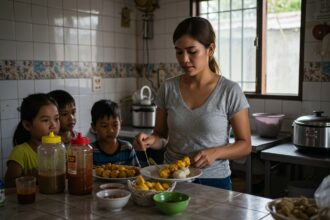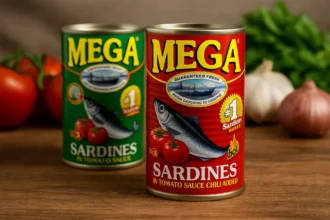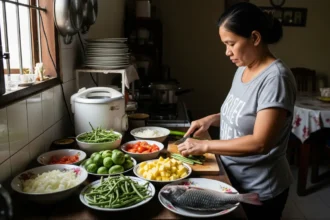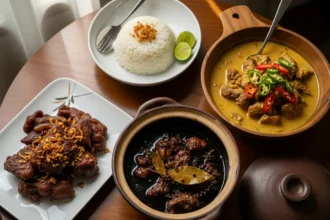In every Filipino household, the pantry is more than just storage – it’s the backbone of survival and daily comfort. Whether you’re preparing ulam for the family, whipping up instant noodles for midnight cravings, or putting together quick meals during emergencies, a well-stocked pantry is the unsung hero of Filipino life.
- 🍚 Rice: The Heart of Every Meal
- 🥫 Canned Goods for Quick and Emergency Meals
- 🥢 Sauces, Condiments, and Seasonings
- 🥚 Eggs, Tofu, and Dried Fish: Budget-Friendly Proteins
- 🍜 Instant Noodles and Quick-Cook Staples
- 🧄 Spices, Aromatics, and Everyday Flavor Boosters
- 📊 Table 1: Core Filipino Pantry Staples and Their Uses
- 🥗 Fresh Produce That Lasts Longer
- 📊 Table 2: Budget Pantry Alternatives to Expensive Items
- 💡 Pros of Stocking a Pinoy Pantry
- ❓ Frequently Asked Questions (FAQ)
- ✨ Final Reflection: The Pantry as the Heart of Pinoy Resilience
- 🫙 References
But what exactly are the must-have Filipino pantry staples? These are the items that keep families fed during budget crunches, typhoon season, or even just lazy weekends. Let’s go through the essentials that every Pinoy kitchen should never run out of.
🍚 Rice: The Heart of Every Meal
Rice isn’t just a staple – it’s the centerpiece of Filipino dining. No meal feels complete without a heaping serving of steaming kanin on the plate. From breakfast with tuyo and itlog, to dinner with adobo or sinigang, rice anchors the Filipino table.
Every household should stock rice in bulk, ideally in 25- or 50-kilo sacks to save money and ensure supply during shortages. Storing it properly in airtight containers keeps it fresh and pest-free. For many families, rice is not just food, it’s security – knowing there’s rice in the house means no one goes hungry.
🥫 Canned Goods for Quick and Emergency Meals
Canned goods are the lifesavers of the Filipino pantry. Whether it’s sardines, corned beef, luncheon meat, or tuna, these items have long shelf lives and can be cooked in multiple ways.
During typhoons and blackouts, canned goods become the first line of defense against hunger. Even on regular days, they make quick ulam for busy households. Adding a little creativity, like sautéing sardines with pechay or mixing corned beef with potatoes, turns simple canned goods into hearty meals.
🥢 Sauces, Condiments, and Seasonings
No Filipino kitchen is complete without an arsenal of condiments. Soy sauce (toyo), vinegar (suka), and fish sauce (patis) are the holy trinity of Filipino cooking. They transform basic ingredients into flavorful dishes like adobo, paksiw, and tinola.
Other staples include bagoong, oyster sauce, banana ketchup, and calamansi juice packets. These condiments ensure meals never feel bland and allow households to recreate lutong bahay flavors on a budget.
🥚 Eggs, Tofu, and Dried Fish: Budget-Friendly Proteins
Not every Filipino family can afford meat daily, which is why alternative proteins are pantry must-haves. Eggs are versatile, lasting days without refrigeration. Tofu (tokwa) is affordable and adapts to stir-fries or adobo. Dried fish like tuyo, daing, or dilis offer strong flavors that stretch rice servings further.
These proteins also have the advantage of longer shelf life compared to fresh pork or chicken, making them reliable during lean days. Having them in the pantry means there’s always a cheap but satisfying ulam option ready to go.
🍜 Instant Noodles and Quick-Cook Staples
Instant noodles are controversial – cheap, tasty, but not the healthiest. Still, no Filipino pantry feels complete without them. They’re reliable during end-of-the-month budget crunches or power outages when quick meals are needed.
Other quick-cook essentials include bihon, misua, and pasta. Combined with pantry condiments and small protein portions, these can be turned into filling family dishes like pancit bihon or sopas.
🧄 Spices, Aromatics, and Everyday Flavor Boosters
Filipino cooking is unimaginable without garlic, onion, and ginger. These aromatics form the base of countless dishes from ginisa to sinigang. Storing a steady supply ensures flavorful meals even with simple ingredients.
Salt, pepper, bouillon cubes, and chili also count as essentials. These small but mighty pantry items keep meals varied and prevent repetition fatigue in budget cooking.
📊 Table 1: Core Filipino Pantry Staples and Their Uses
| Category | Examples | Common Uses | Shelf Life |
|---|---|---|---|
| Rice & Grains | White rice, bihon, misua, pasta | Everyday meals, pancit, sopas | 6–12 months |
| Canned Goods | Sardines, corned beef, tuna | Emergency meals, quick ulam | 1–2 years |
| Condiments | Soy sauce, vinegar, patis, bagoong | Flavoring adobo, paksiw, ginisa | 1–2 years |
| Proteins | Eggs, tofu, tuyo, daing | Affordable ulam options | Days–months |
| Spices & Aromatics | Garlic, onion, ginger, bouillon | Base flavors for lutong bahay | 2–6 months |
🥗 Fresh Produce That Lasts Longer
While many vegetables spoil quickly, some are reliable pantry-friendly gulay. Kamote, kalabasa, sayote, and cabbage last longer without refrigeration. They provide nutrition and bulk for meals when fresh produce runs low.
Adding these hardy vegetables to dishes helps stretch proteins and rice further, making them indispensable for budget-conscious families.
📊 Table 2: Budget Pantry Alternatives to Expensive Items
| Expensive Item | Cheaper Pantry Substitute | Example Dish |
|---|---|---|
| Pork belly (liempo) | Tokwa or eggplant | Tokwa’t baboy (tokwa-heavy) |
| Chicken breast | Sardines + gulay | Sardinas with pechay |
| Beef tapa | Canned corned beef with potatoes | Corned beef ginisa |
| Imported pasta sauce | Tomato paste + ketchup | Spaghetti ala Pinoy |
| Fresh seafood | Dried fish (tuyo, daing) | Tuyo with tomatoes and egg |
💡 Pros of Stocking a Pinoy Pantry
- ✅ Ensures food security during typhoons and emergencies.
- ✅ Saves money by avoiding frequent trips to the store.
- ✅ Allows quick cooking even with limited fresh ingredients.
- ✅ Preserves Filipino flavors at home.
- ✅ Reduces reliance on expensive takeout or fast food.
❓ Frequently Asked Questions (FAQ)
Q1: What’s the most important Filipino pantry staple?
Rice is hands down the most important. It’s the foundation of every Filipino meal, and without it, many households feel incomplete at the table.
Q2: How long do pantry staples usually last?
Canned goods can last 1–2 years, rice 6–12 months if stored properly, and condiments up to 2 years. Dried fish lasts weeks if stored in a dry place, while eggs typically last a week without refrigeration.
Q3: Are instant noodles bad as pantry staples?
They’re not ideal for nutrition but work well for emergencies. Pairing noodles with vegetables and eggs helps make them healthier and more filling.
Q4: How can I keep pantry staples organized?
Use labeled containers, arrange by category, and apply “first in, first out” to avoid spoilage. Airtight storage also prevents pests, especially for rice and flour.
Q5: What should be stocked for emergencies like typhoons?
Focus on rice, canned goods, bottled water, instant noodles, dried fish, and matches/candles. These last longer and ensure food supply when electricity is out.
Q6: Can pantry staples really lower grocery costs?
Yes. Bulk buying rice, condiments, and canned goods saves money long-term. Having staples on hand also prevents expensive last-minute takeout orders.
Q7: What affordable proteins are best for pantries?
Eggs, tofu, and dried fish are reliable, cheap, and flexible. They also pair well with rice and gulay, making them essential.
Q8: How do I balance nutrition with cheap staples?
Supplement rice and canned goods with vegetables and alternative proteins. Adding malunggay or sayote to dishes boosts nutrition without extra cost.
Q9: Should I stock imported goods or just local staples?
Local staples are more affordable and sufficient for most meals. Imported items like pasta or sauces are optional and often less practical during price hikes.
Q10: How do I prevent pests in rice storage?
Keep rice in airtight containers and add bay leaves or garlic cloves to repel insects naturally. Regularly clean storage areas to avoid infestation.
✨ Final Reflection: The Pantry as the Heart of Pinoy Resilience
A Filipino pantry is more than shelves and containers – it’s a living symbol of security, care, and resilience. Each sack of rice, each can of sardines, and each bottle of toyo represents not just food but the ability of Filipino families to withstand uncertainty.
In times of crisis, whether typhoons or inflation, pantry staples ensure no one goes hungry. During ordinary days, they become the foundation of everyday lutong bahay, feeding both body and soul. They are proof that even with little, Filipino families can make much.
Stocking wisely doesn’t just save money – it preserves traditions and strengthens family ties. A meal of rice and tuyo can be as meaningful as a feast, because what matters is not the cost but the love poured into cooking. The pantry, therefore, is not just storage; it is a mirror of Filipino resilience and creativity in the face of hardship.
🫙 References
-
ThePeachKitchen – Pantry Essentials: 7 Must-Have Ingredients
-
Campfire Crates – How Stocking a Filipino Pantry Helps Connect Your Family
-
Facebook Filipino Cooking Group – Filipino pantry staples? Go!
-
Shopee Blog – The Sunday Reset: Your Guide to Meal Planning
-
Golden Buffalo – 5 Must-Have Filipino Pantry Staples
-
Pluxee PH – Here’s where to use your allowances in each city










